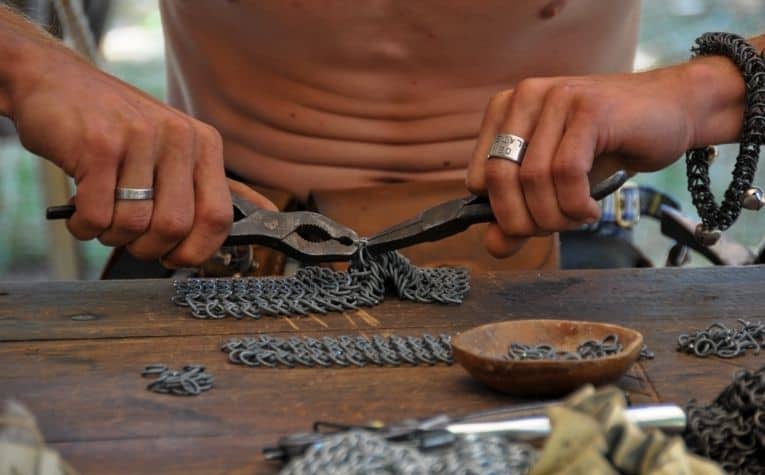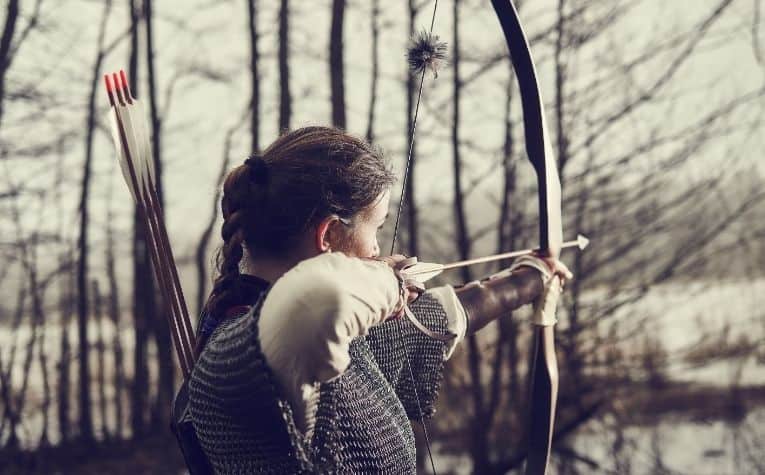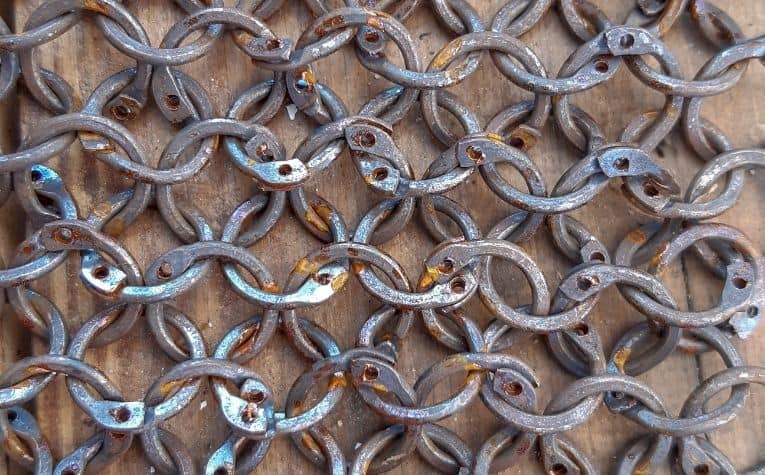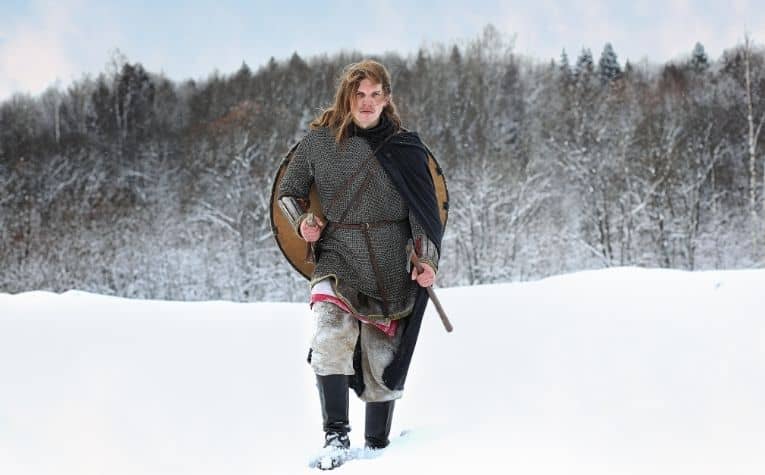For nearly two and half centuries during the Middle Ages, the Vikings were the greatest and most feared military force in Europe.
Keys to their dominance were a fearless approach toward battle, elite fighting skills, and weaponry that perfectly suited their preferred combat methods.
But an often overlooked aspect of the Vikings and their armament is how they used defensive implements, particularly armor.
Chainmail was in use as protective armor throughout Medieval Europe, and the Vikings were certainly no exception.
However, due to the high cost of the various metals needed and the extremely laborious nature of fabricating it, only very wealthy and powerful members of Viking society wore chainmail.
The Vikings believed their destinies were pre-ordained by the Norse gods and they were largely unafraid of death.
To die on the field of battle was the most honorable way for a Viking warrior to leave the mortal realm and perhaps earn entry into Valhalla.
Keep reading to learn the role that chainmail played in their approach to battle.
Ever wonder what the Vikings wore? See The Viking Dress Code: What They Wore and How to learn more.
Did Viking Warriors Wear Chainmail?

As great military tacticians, the Vikings knew all too well the importance of armor during battle, particularly chainmail.
In fact, chainmail (or the lack thereof) may have played a crucial role in ending the Viking Age.
Unlike swords, axes, and other weapons, scant archeological discoveries have been made in Scandinavian graves that contain chainmail (often referred to simply as mail).
This is not to say that Viking warriors did not wear it, as it is possible that because of chainmail’s tremendous value in battle, it would have been passed on as a family heirloom rather than buried as part of a deceased warrior’s grave goods.
How did the Vikings wear their hair? See Did the Vikings Wear Dreadlocks? learn more.
What is beyond dispute is that iron, from which virtually all forms of chainmail would have been made during the Viking Age, was difficult to source.
Additionally, the thousands of rings, which comprised even a basic article made from chainmail, required extensive labor to produce and link together.
As such, chainmail was very expensive to acquire and only worn by a select few Viking society members. [1] [2]
The Viking Elite Wore Chainmail

According to Norse sagas, chainmail was worn by Viking kings and their hand-picked fighting forces.
Perhaps most famously, King Harald Hardrada of Norway (considered by many to be the last great Viking king) relied so heavily on his coat of mail that he affectionately named it Emma.
He was reputedly impervious to the blows of enemy swords, axes, and arrows whenever he was cloaked in it.
In a bit of irony (no pun intended), on a hot September day in 1066, during a military campaign in England, King Harald and his battalion had left their chainmail armor behind at camp as they surveyed the English countryside.
Surprised by the unexpected arrival of English forces, the mail-less King Harald was killed at the Battle of Stamford Bridge.
It is worth noting that by many historical and scholarly accounts, the Viking Age informally ended with King Harald’s death, as his failed attempt to gain control of England was the last Viking invasion.
(England was subsequently invaded by the Normans from Northern France, who were themselves directly descended from Vikings.) [3] [4]
Why Didn’t All Viking Warriors Wear Chainmail?

The type of chainmail that was in fashion during the Viking Age was long-sleeved to protect the arms and typically went down to the waist.
According to the Icelandic poet Snorri Sturluson, whose poems and sagas are among the few bodies of work devoted to all things Viking, King Harald of Norway wore a chainmail coat extending below his knees.
Even though chainmail must have been significantly lighter and less cumbersome than a suit of plate armor made from thousands of rings of iron, it would still have been a significant article to wear during battle.
A typical chainmail coat would have had the following measurements:
- Length – roughly three feet (900 mm) from shoulders to thighs with enough room to run, crouch, and mount a horse
- Width – roughly two feet (600 mm) across from shoulder to shoulder (and allowing for freedom to move the arms)
- Weight – approximately 30 pounds (14 kilograms)
Prohibitive cost aside, it is debatable whether the common Viking warrior would have opted for a coat of chainmail even if he could afford to own one.
Among the fighting attributes for which the Vikings were best known was their elite skill in hand-to-hand combat, especially in close quarters. [5] [6]
The Vikings were devoted to Norse mythology before converting to Christianity. See Norse Mythology vs Christianity learn more.
Viking Warriors Depended on Maneuverability

Given its weight and the fact that it was essentially a woven coat made from iron, chainmail may have been disdained by many Vikings who would have felt that the burden of wearing it outweighed its benefit.
Considering that battles during the Middle Ages raged for hours on end with non-stop action between combatants, shouldering an extra 30 pounds would certainly have been physically draining.
Another consideration is that the most common weapons wielded by the typical Viking warrior were:
- Axes
- Spears
- Short swords
Unhindered movement of the arms was crucial to properly swinging and controlling these implements.
Common Viking armament also included round, wooden shields that would have been held with one hand, so freedom of movement was important for defensive purposes as well.
Besides, since the vast majority of Viking forces were essentially foot soldiers, the ability to move and maneuver freely was of the utmost importance.
It is also worth noting that not only was chainmail heavy to wear, it could also become unbearably hot during the summer and early autumn months, which is when many Viking raids and military campaigns took place.
By several accounts, in a cruel twist of fate King Harald and his men left their chainmail behind because, on the day of the Battle of Stamford Bridge, the weather was particularly hot in England. [7]
What Armor did the Common Viking Warrior Wear?
Most Viking warriors probably went into battle armed with only an axe or a spear and a round shield made from ash or pine to defend himself.
The fact that the Vikings dominated Northern Europe for over two centuries with such humbly-armed forces is a testament to their:
- Unparalleled bravery
- Elite fighting skills
- Irrepressible mental fortitude
For those Vikings who did wear armor but did not have the status or the means to acquire chainmail, they chose from several less expensive and more readily available options.
Viking Lamellar Armor
Researchers have found archeological evidence that aside from chainmail, the Vikings also used another form of metal armor.
This simple metal coat, known as lamellar armor, was discovered in Birka, Sweden.
It is believed to have originated in the Byzantine Empire (modern-day Turkey) or the region that is now Russia. (Viking mercenaries are known to have served in these areas centuries ago.)
Lamellar armor consisted of small iron or steel plates that were linked to each other with leather laces.
Overlapping rows of these metal scales would form a coat of armor that could be worn over clothing, such as the tunic worn by most Viking men.
While not as effective against enemy weapons as chainmail, lamellar was the next best option. [8] [9]
Leather Armor
Another form of armor worn by some Viking warriors was made from pieces of padded leather or thick, quilted cloth like wool or linen.
While these types of armor were reserved for the common Viking man, they did offer a moderate degree of protection against the slashing motions of bladed weapons like swords and axes.
Leather armor (of the reindeer variety) was even mentioned in the Viking poem Saga of Olaf as being worn by the protagonist Thorir Hund. [10]
Conclusion
The Vikings were fearless warriors but not foolhardy, as evidenced by the chainmail worn by their kings and elite fighting forces.
References:
[1] norsemythology.org
[2] ancient-origins.net
[3] vikingeskibsumuseet.dk
[4] medievalists.net
[5] weaponsandwarfare.com
[6] medievallondon.ace.fordham.edu
[7] warriorsandlegends.com
[8] englishhistory.net
[9] forgeosvan.com
[10] blog.vkngjewelry.com
